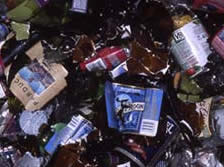|
Imagine the following: You go to the kitchen, pull a glass out of the cabinet, and pour a delicious glassful of "Wheat Grass and Cranberry Spritzer" or whatever drink suits your fancy. You drink it down. Mmm. Then you
 put the glass in the recycle bin. Every time you or someone else in your household uses a glass for a drink, into the recycle bin it goes. Every week when you go to the grocery store, you buy new glasses. Keep imagining.... Restaurants do the same thing—every glass of wine, beer, water or whiskey they serve requires a new glass, rather than being served in a glass that gets washed and reused.
put the glass in the recycle bin. Every time you or someone else in your household uses a glass for a drink, into the recycle bin it goes. Every week when you go to the grocery store, you buy new glasses. Keep imagining.... Restaurants do the same thing—every glass of wine, beer, water or whiskey they serve requires a new glass, rather than being served in a glass that gets washed and reused.
What is the point of this Bizarro World of Glassware? The idea is to imagine the inefficiency that would be inherent in such glass use:
- the energy required to transport and process the additional "glass to be recycled";
- the energy required to create the new glassware from recycled glass (or from raw materials, when people aren't recycling properly);
- the pollution associated with these operations;
- or, in the worst case, where people are too lazy to recycle their glasses, the disposal costs.
Of course, we do not do this with the glasses in our kitchen cabinets—we reuse them hundreds of times. But realize that the Bizarro World of Glassware DOES apply to glass bottle packaging. The glass bottles and jars in which we buy juice, fancy teas, spaghetti sauce, and other food and beverage products are not cleaned and reused in the US, they are recycled (or, all too often, just tossed in the trash). Even the better case, recycling, requires the glass bottle packaging to be stripped of its labels, melted down, and reformed into new glass. This is far more energy-intensive than sterilizing and reusing the bottles.
So, why don't we do the sensible thing and reuse glass bottles? Or is this idea just a brainless pipedream from someone who's taken one too many swigs off the ol' bottle of prune ripple?
Recycling glass does indeed save energy as compared to using raw ingredients to make new glass.
 The Glass Packaging Institute notes that energy costs drop about 2-3% for every 10% of recycled glass used in the manufacturing process. Glass bottle recycling also reduces resource use and pollution.
The Glass Packaging Institute notes that energy costs drop about 2-3% for every 10% of recycled glass used in the manufacturing process. Glass bottle recycling also reduces resource use and pollution.
But what about glass bottle reuse? Good news! Costs drop even more when glass packages are sterilized and reused without being crushed, melted, and reformed. There are many factors that affect the costs and efficiencies associated with a bottle reuse program as compared to recycling "non-refillables," including:
- Whether deposits on refillable bottles (or taxes on non-refillable bottles) are required to increase recovery rates of refillables.
- How successful local recycling programs are at collecting non-refillable bottles.
- How willing retailers are to accommodate collection programs for refillables.
- Whether the beverage industry will geographically restructure its bottling operations to reduce the distance traveled by refillables.
- Whether beverage companies will collaborate to use industry-standard bottles (or whether governments are willing to force them to do so).
Cost-benefit analyses must make assumptions about these and other factors related to consumer behavior, government policy, manufacturers' attitudes, and more. But studies have indeed been done, and overall the message is clear—from an efficiency standpoint, using refillable glass bottles is one of the least costly packaging methods, beating even the lowly wax-covered carton, which is one of the least-expensive one-way packaging options. The most expensive packaging option—of any kind—is usually found to be non-returnable glass bottles.
So, if it's so economically advantageous, why don't we do it?
There are three main sticking points when it comes to changing over from using disposable glass bottles to using refillable glass bottles. The first is the beverage industry, where packaging has become part of marketing. Whether the bottle is plastic or glass, companies like having complete control over bottle characteristics like shape, color, opacity, and surface roughness. All of these things play a part in presenting the beverage to consumers in just the right way—at least in the minds of today's fuzzy-headed marketers.
|
To make any re-use process efficient, one would have to greatly reduce the number of bottle configurations so bottles are no longer manufacturer-specific and can be reused in a way that minimizes transport distances. But moving to a system like this would largely remove the glass bottle from the marketing equation, and the beverage industry doesn't like that idea at all. Further, they perceive customers to be convenience-oriented, and anything that might discourage them from making a purchase—such as not wanting to have to worry about returning a bottle to get the deposit back—is opposed by manufacturers.
|
|
THE CRITIC HAD A GLASS “BUT”... |
|
One additional argument critics sometimes use to make glass-bottle reuse seem inefficient is to say that consumers would have to burn gasoline to get the bottles to the pickup point. This is a specious argument—if consumers take the bottles back to their grocery store as part of their normal shopping trip, there is no additional gasoline use. Similarly, when new bottled products are shipped from bottling plants to stores, the trucks would take the empties back to the plant on the return trip (instead of being empty). There could actually be a net transportation savings since curb-side recycling costs would be lowered due to less weight to transport.
|
|
The second barrier to bottle reuse is food-store chains, who are none-too-enthusiastic about the idea of having to collect bottles. It takes space and (usually) extra people to manage collection and deposit refunds.
The third major sticking point to glass bottle reuse is, I am sad to say, us. We consumers seem to be generally happy with a throw-away society—especially here in the US—and glass bottles are no exception. Many of us are willing to put our glass containers in the recycling bin, but only about 25% of glass packaging is recycled in the US. And anyway, the point of the article is that even if you are a good recycler, turning recycled glass bottles back into new bottles takes more energy than simply reusing them.
There are a lot of hurdles to replacing our approach of recycling glass bottles with a new program of reusing them. It will require a change in consumer mindset and a large amount of grassroots pressure to overcome the hammerlock the beverage industry has on government lawmakers. But it can be done—that's how recycling programs got started!
You can get more information about refillable beverage containers, glass or otherwise, at the web site of the Grassroots Recycling Network.
|


